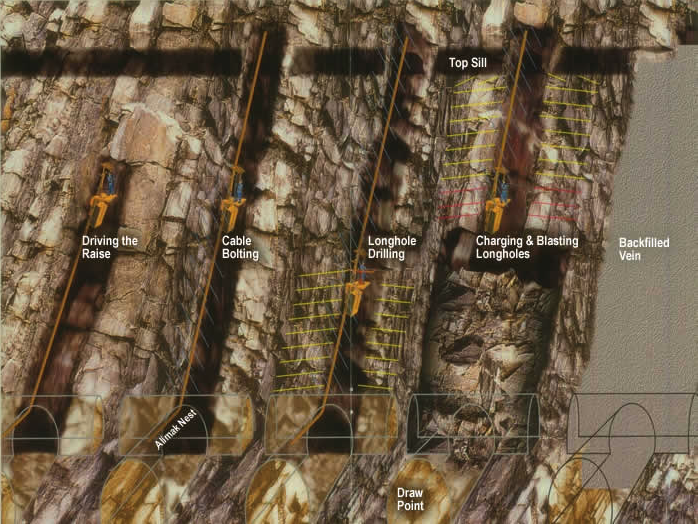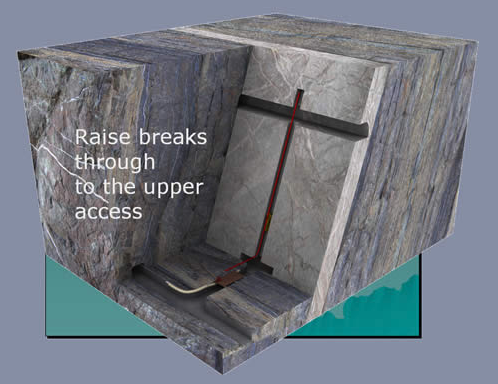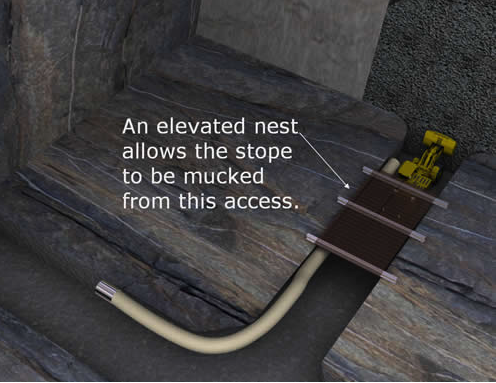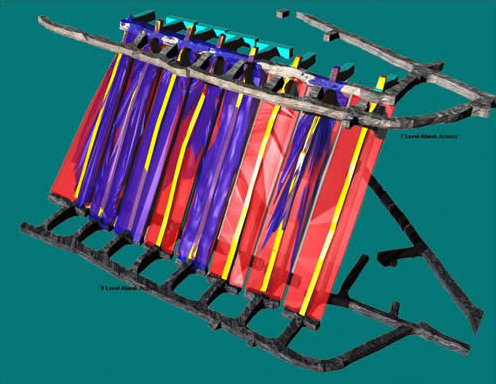A true innovation in underground mining, the Alimak Mining Method provides high safety standards while increasing productivity, adding greater flexibility and reducing overall mining costs.
Manroc employs highly qualified mining engineers and associates with extensive experience in underground mining. Our expertise ranges from the early stages of evaluation and feasibility, the intermediary planning stages of design and development, and the final stages of project development and production.
Manroc’s professional mine engineering team will work closely with your engineering staff to assist you with all of your mine planning needs.
A True Innovator in Underground Mining
Manroc Developments Inc. is recognized as a leading Alimak Mining contractor, working with major mining companies around the world. We succeed through our commitment to serving our clients’ needs for safe, low-cost mining techniques, that yield high tonnage / low dilution results.
The Alimak Mining Method
Orebody Requirements
This type of mining is best suited for narrow vein orebodies with enough dip to allow for gravity-led ore flow. The ore boundaries can be interpolated between adjacent raises, allowing drill design to be adjusted as required and the ore can therefore be mined with more precision.
Raise Climber Mining Method Details
The raise climber mining method will generally be comprised of the following steps:
Lateral Development
Bottom Sill: These drifts are driven from the shaft or established mining areas to the new ore zone. The drifts are commonly sized to accommodate the large scooptrams used for production mucking.
Drawpoints and Climber Nest: Drawpoints can be driven from either footwall or hangingwall, depending on how the ore zone is accessed. The climber nests are always in the hangingwall. The climbers require about 4.3 metres width, 2.7 metres of height and 12 metres of length, though they are often driven longer to accommodate the rescue unit and/or lower dipping orebodies.
Top Sill Access: These drifts are also driven from the shaft or existing development but are not always required for the Alimak Mining Method when advanced blasting systems are implemented.
Raise Excavation
Raise Development: Raises must be large enough to accommodate a 2.4 metre drill, roughly 2.7 x 2.7 metres horizontally. Primary ground support is installed with each round taken.
Raise Rehabilitation: After the raise is driven to its’ entirety, secondary ground support is installed (subject to ground conditions) for the safety of the production crews.
Hangingwall Support: Where required, the stope hangingwall is supported with deformed strand resin-grouted cable bolts at a regular pattern along the length of the raise. This is an effective means to minimize dilution, as the raise is centred in the stope and therefore the support is installed where it is needed most.
Production
Drilling: Drill holes extend to just less than half way to the next raise and dip down from horizontal. The down dip helps the toes break to the stope wall. Hole diameters are often fairly small to avoid hangingwall / footwall damage in narrow veins.
Loading & Blasting: The holes are most often mechanically loaded with either ANFO or an emulsion explosive. The blasts are timed to slash down into the sill (which serves as a slot), with the footwall holes often the last to fire.
Mucking Swell: In most cases, the majority of the ore remains in the stope during the blasting phase to support the walls during successive blasts, with just enough being mucked out to provide a void for the next blast. The broken ore compacts, resulting in a swell of approximately one third its unbroken volume.
Final Mucking: Once blasting is complete, the stope is mucked clean and backfilled if required.
Advantages to
Alimak Raise Mining
Less Development
Narrow vein orebodies tend to have lower tonnages, making them more sensitive to excess development costs. There is significantly less waste development with raise mining than with regular open stoping
In many cases, there may be no need for a ramp, an upper sill, a muck pass and / or a ventilation raise as there would be in a conventional longhole stoping system. The bulk of the waste development required with this method is the ore zone access and the raise climber “nests”.
The need for sublevels and their associated development can be eliminated, as the change in geometry and improvement in ground support allows stope heights in the order of 75 to 150 metres.
Less Dilution
Cablebolts are often installed along the hangingwall, in the centre of the stope where they are most effective. The stopes are mined shrinkage-style , with added support gained from the broken ore remaining in place.
More Selectivity
The geology is exposed down the entire dip length of the stope on both sides of the raise. The ore contacts can be both extrapolated from across the raise and interpolated between raises. Stopes can be as narrow as one meter, or even less in ideal circumstances.
Faster Overall Extraction
With better ground control, larger stopes can be taken. Fewer, larger stopes can be taken quicker because there are fewer cycles, i.e., fewer final surveys, fill fences, and backfill arrangements.
Lower costs
With less development, faster ore access, better ground control, and faster overall mining, it is easy to see how raise mining will cost less than conventional longhole stoping.
Mass Blasting
Over the years, we have been perfecting a method which enables us to blast a stope in its entirety. With suitable orebody parameters, we have been able to load the entire stope and using electronic blasting caps, blast the entire stope as a “one-shot wonder”.
For a mass blast, the raise is typically no longer than 100 meters long and thin enough that the swell fits in the same volume as the raise and undercut combined, as this is used as the void. Manroc has been very successful at mining orebodies with widths as narrow as 1 metre, while maintaining a very desirable dilution, which is in most cases much better than the dilution obtained by conventionally mined stopes.
Manroc’s mass blast stope design offers several advantages. Less development, specifically less waste development, offers substantial cost savings. The stope being blasted all at once means it will take less time to get the ore on the ground. Additionally, there will be only the one blast clearance as opposed to several throughout the blasting of the stope.
Moving forward, there have been significant advancements in wireless blasting technologies that allow for multiple blasts within a single, fully-loaded stope. This technology eliminates the limitations for lower-access only stopes, yielding even more costs savings.
Our Commitment
We strive to exceed our client’s expectations. We value safety above all else and it is our belief that safety is a state of mind that starts with common, everyday practices. We are a solid team of experienced personnel with the tools, training and support needed to succeed. We ensure that everyone goes to work every day focused on achieving results in a safe and efficient way in order to deliver quality work in a safe and timely manner.



